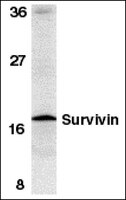A soluble form of the receptor for advanced glycation endproducts (RAGE) is produced by proteolytic cleavage of the membrane-bound form by the sheddase a disintegrin and metalloprotease 10 (ADAM10).
Raucci, A; Cugusi, S; Antonelli, A; Barabino, SM; Monti, L; Bierhaus, A; Reiss, K; Saftig, P; Bianchi, ME
FASEB journal : official publication of the Federation of American Societies for Experimental Biology
22
3716-27
2008
Zobrazit abstrakt
The receptor for advanced glycation endproducts (RAGE) mediates responses to cell danger and stress. When bound by its many ligands (which include advanced glycation endproducts, certain members of the S100/calgranulin family, extracellular high-mobility group box 1, the integrin Mac-1, amyloid beta-peptide and fibrils), RAGE activates programs responsible for acute and chronic inflammation. RAGE is therefore also involved in cancer progression, diabetes, atherosclerosis, and Alzheimer's disease. RAGE has several isoforms deriving from alternative splicing, including a soluble form called endogenous secretory RAGE (esRAGE). We show here that most soluble RAGE, either produced by cell lines or present in human blood, is not recognized by an anti-esRAGE antibody. Cells transfected with the cDNA for full-length RAGE, and thus not expressing esRAGE, produce a form of soluble RAGE, cleaved RAGE (cRAGE) that derives from proteolytic cleavage of the membrane-bound molecules and acts as a decoy receptor. By screening chemical inhibitors and genetically modified mouse embryonic fibroblasts (MEFs), we identify the sheddase ADAM10 as a membrane protease responsible for RAGE cleavage. Binding of its ligand HMGB1 promotes RAGE shedding. Our data do not disprove the interpretation that high levels of soluble forms of RAGE protect against chronic inflammation, but rather suggest that they correlate with high levels of ongoing inflammation. | 18603587
 |
Control of apoptosis and mitotic spindle checkpoint by survivin.
Li, F, et al.
Nature, 396: 580-4 (1998)
1998
Zobrazit abstrakt
Progression of the cell cycle and control of apoptosis (programmed cell death) are thought to be intimately linked processes, acting to preserve homeostasis and developmental morphogenesis. Although proteins that regulate apoptosis have been implicated in restraining cell-cycle entry and controlling ploidy (chromosome number), the effector molecules at the interface between cell proliferation and cell survival have remained elusive. Here we show that a new inhibitor of apoptosis (IAP) protein, survivin, is expressed in the G2/M phase of the cell cycle in a cycle-regulated manner. At the beginning of mitosis, survivin associates with microtubules of the mitotic spindle in a specific and saturable reaction that is regulated by microtubule dynamics. Disruption of survivin-microtubule interactions results in loss of survivin's anti-apoptosis function and increased caspase-3 activity, a mechanism involved in cell death, during mitosis. These results indicate that survivin may counteract a default induction of apoptosis in G2/M phase. The overexpression of survivin in cancer may overcome this apoptotic checkpoint and favour aberrant progression of transformed cells through mitosis. | 9859993
 |











